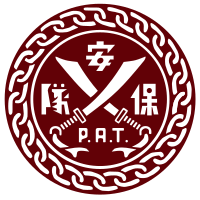| Pao An Tui | |
|---|---|
 Pao An Tui emblem  Pao An Tui recruits in Bandung | |
| Also known as | Poh An Tui, Po An Tui, Poh An Tuy, Po An Tuy |
| Leaders | Loa Sek Hie (Chairman) Oey Kim Sen (Deputy Chairman) Khouw Joe Tjan (Secretary) Cong Fai-kim (Treasurer) |
| Dates of operation | 1946-1949 |
| Headquarters | Batavia, Dutch East Indies |
| Active regions | Parts of Java, Sumatra, Borneo |
| Allies | |
| Opponents | |
| Pao An Tui | |||||||||||||||
|---|---|---|---|---|---|---|---|---|---|---|---|---|---|---|---|
| Traditional Chinese | 保安隊 | ||||||||||||||
| Simplified Chinese | 保安队 | ||||||||||||||
| |||||||||||||||
Pao An Tui (Chinese: 保安隊; pinyin: Bǎo'ān duì; Wade–Giles: Pao3-an1-tui4; Pe̍h-ōe-jī: Pó-an-tūi; lit. ''public security corps'') sometimes spelt Po An Tui or Poh An Tui from the Hokkien pronunciation, were self-defense forces of the Chinese-Indonesian community during the Indonesian National Revolution from 1945 to 1949.[2][1] The group has been accused by Indonesian nationalists of harbouring pro-Dutch sympathies during the Revolution, especially during the police actions,[3] though it received arms and support from both sides of the conflict.[4][5] Pao An Tui was disbanded in 1949 with the cessation of violence and the conclusion of the revolution in Indonesian Independence.[1]
- ^ a b c Willmott, Donald E (2009). The national status of the Chinese in Indonesia 1900–1958 (First Equinox ed.). Jakarta: Equinox Publishing. ISBN 9786028397285. Retrieved 16 December 2016.
- ^ Tong, Chee Kiong (2010). Identity and ethnic relations in Southeast Asia racializing Chineseness. Dordrecht: Springer. ISBN 9789048189090. Retrieved 16 December 2016.
- ^ Subarkah, Muhammad (28 February 2016). "Pao An Tui, Sisi Kelam Masyarakat Cina di Indonesia". Republika Online (in Indonesian). Retrieved 27 March 2023.
- ^ Cite error: The named reference
Chee Kiong Tong (2010was invoked but never defined (see the help page). - ^ Setiono, Benny G. (2003). Tionghoa dalam pusaran politik. Jakarta: Elkasa. ISBN 9799688744. Retrieved 16 December 2016.
